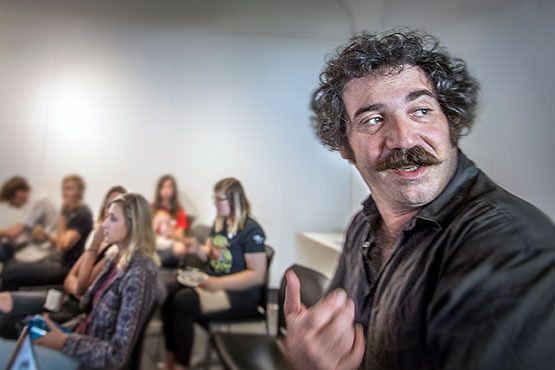
News . Feature Stories . Visiting artist Rakowitz finds the power of orange
News
October 24, 2017
Visiting artist Rakowitz finds the power of orange
'I don't want to be polite as an artist'

Photo by Robert Muller/CIA.
By John Campanelli
When Chicago-based artist Michael Rakowitz stopped by the Cleveland Institute of Art in October, he kept an overflow audience of students spellbound as he described his approach to art and unveiled an audacious project in the works for Cleveland in 2018.
So much of art, he said, comes from connections. And his plans for a Cleveland art project will be one more link in the chain.
Rakowitz was doing a residency in Jordan in the 1990s while working on his master’s in visual arts at MIT in Boston. He studied the camps of the nomadic Bedouin Arabs and how they positioned their tents to take advantage of warm dessert winds. Back in Boston, he noticed that homeless people did the same thing, using the warm air that blew from street-level building vents. The connection became paraSITE, dozens of custom-built temporary tents for the homeless, plastic structures that attach to building vents and then are inflated and heated by their exhaust.
“It’s a type of architectural CPR, one building blowing life into the lungs of another,” Rakowitz told the students. “It’s a way I could take something invisible, like excess air, and turn it into something that could be physicalized. … It’s a way to make visible what the city wants to hide.”
Then there’s the color orange. In 2010, Rakowitz wrote a short piece on Sir William Coldstream’s 1974-75 painting “Orange Tree I.”
He wrote about how Natalia Dmytruk, a Ukrainian TV news sign-language interpreter, had defied the government in 2004 by telling deaf viewers that the election results she was translating were lies. She tucked an orange scarf, a symbol of the county’s Orange Revolution, into her sleeve. It revealed itself while she gestured.
“I find myself compelled by moments that occur in everyday life and are not intended to exist as poetry or art, but accidentally become such,” he wrote.
While working on a project involving Iraqi dates (the fruit), Rakowitz found himself inside a warehouse in Dubai with bags stacked to the ceiling. “The orange of the date bags was reflecting on the white walls,” he said. “The colors, it was better than any James Turrell art project I ever saw.” He felt the urge to replicate the scene.
And now, Rakowitz is working on an exhibition for SPACES Gallery in Cleveland — and the date bags seem somehow connected.
In 2014, Cleveland police shot and killed 12-year-old Tamir Rice in a Cleveland park. The police cited the removal of the orange tip of Tamir’s pellet gun in explaining their reaction. The case captured Rakowitz's attention — in part because of his previous projects, and in part because he had been invited by Case Western Reserve University's Beamer-Schneider Professor of Ethics to deliver a biennial ethics address. Tamir Rice, and other cases of police violence, became part of Rakowitz's preparatory work for the April 2015 lecture, "There's a crack in everything; that's how the light gets in."
Out of that, he conceived his current project, "A Color Removed." Working with SPACES and CWRU, Rakowitz has begun an audacious and provocative project to remove orange, the “color of safety,” from the entire city. The project involves formal letter-writing campaigns urging the removal of everything orange, from traffic cones to Cheez-Its. Collection bins will appear through Cleveland in early 2018 for the public to drop off orange toys, clothing and household objects. They will then be displayed, floor to ceiling, inside SPACES, replicating Rakowitz’s epiphany in Dubai.
“It’s important that’s we’re haunted by this,” Rakowitz said. “We’re way too comfortable. I don’t want to be polite as an artist. I hate polite art.”
After the presentation, Rakowitz said that he cherishes these types of interactions with art students. “There’s always a willingness to take risks, a desire to be a little bit unsafe, to be a little impolite from this population,” he said.
He wants them to be skeptical of the art world’s attitudes toward acceptance.
“Don’t always ask for permission. Be willing to make your own scene,” he said. “We are supposed to be disturbing the peace.”
Latest Headlines view all
-
April 02, 2024
Cleveland Institute of Art students partner with Progressive Art Collection to exhibit Ready, Set, Relay! -
March 04, 2024
Cleveland Institute of Art announces Curlee Raven Holton Inclusion Scholar Program -
November 06, 2023
Collision of art and artificial intelligence creates murky waters for artists, curators and educators
Questions?
For more information about this or other CIA news, contact us here.
Social Feed